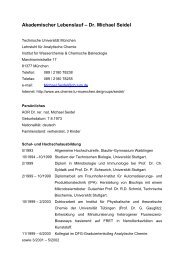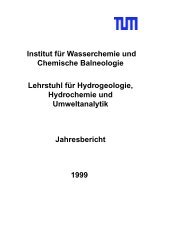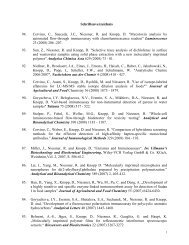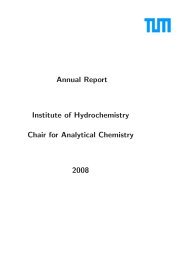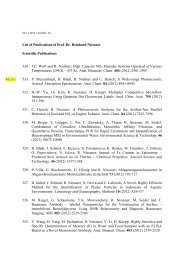IWC Annual Report 2003 - Institut für Wasserchemie und chemische ...
IWC Annual Report 2003 - Institut für Wasserchemie und chemische ...
IWC Annual Report 2003 - Institut für Wasserchemie und chemische ...
You also want an ePaper? Increase the reach of your titles
YUMPU automatically turns print PDFs into web optimized ePapers that Google loves.
12<br />
1.2.3 Production of Polyclonal Antibodies Against Homocysteine<br />
F<strong>und</strong>ing: Hong Kong University of Science and Technology (Prof. R. Renneberg) and<br />
<strong>IWC</strong>/TUM<br />
Homocysteine is a non-essential thiol-containing amino acid formed as an intermediate<br />
during the metabolism of methionine. Normal basal concentration in blood plasma<br />
ranks from 5 to 15 µM. Elevated concentration of homocysteine has become a focus<br />
of research interest since it was established as a clinical risk factor for vascular dysfunctions<br />
that may lead to arteriosclerosis, stroke as well as cerebrovascular, peripheral<br />
vascular and coronary heart diseases. This is the backgro<strong>und</strong> for the steadily increasing<br />
demand for the analysis of this compo<strong>und</strong> in plasma. As analytical methods, GC-MS,<br />
LC-MS-MS, HPLC, CE, and immunoassays are applied. The latter is performed either<br />
as fluorescence polarization immunoassay, chemiluminescence immunoassay, or<br />
ELISA.<br />
All immunoassays use the same commercially available antibody<br />
which was prepared against an S-adenosyl-L-homocysteine<br />
conjugate. As a consequence, sample preparation includes enzymatic<br />
conversion of free homocysteine to S-adenosyl-L-homocysteine<br />
by the action of S-adenosyl-L-homocysteine hydrolase.<br />
Mainly because of this and a second enzymatic step in sample<br />
preparation the immunoassay is rather time-consuming and<br />
costly. If a specific antibody could be prepared directly against<br />
homocysteine its use would facilitate immunological analysis significantly.<br />
Because of the small size of the analyte, its structural<br />
similarity to several other compo<strong>und</strong>s which are formed in different<br />
metabolic pathways, antibody generation is an enormous<br />
challenge.<br />
This project is devoted to this challenge. Based on new analyteprotein<br />
conjugates new immunizations were started. Presently,<br />
gained antisera are characterized and main efforts are directed on the development of<br />
assay formats which circumvent “bridge recognition”.<br />
(A. Deng)<br />
1.2.4 Biomimetic Optical Sensors for Environmental Endocrine Disruptor<br />
Screening (MENDOS)<br />
F<strong>und</strong>ing: EU (QLK-4-CT2002-02323)<br />
During the last years endocrine disrupting chemicals (EDCs) have become suspects<br />
in various reproductive anomalies in humans and wildlife, mimicking the behaviour of<br />
estrogen and other endogeneous hormones. The aqueous phase is the dominant environmental<br />
distribution system for these compo<strong>und</strong>s. The main goal of this project is<br />
the development of novel artificial receptor based optical sensor systems and their application<br />
for assessing and screening EDCs in the environment. The artificial receptors<br />
are prepared by molecular imprinting technology.<br />
First, we focused on imprinting benzo(a)pyrene. This compo<strong>und</strong> is<br />
one of the best known carcinogenic PAH and is also considered to act<br />
as an endocrine disruptor. To our knowledge, only two groups reported<br />
so far on molecular imprinting using PAHs as template/analyte. One<br />
group used PAHs of different size and shape from naphthalene (two<br />
rings) up to perylene (four rings) and cross-linked polyurethane as the polymer matrix



